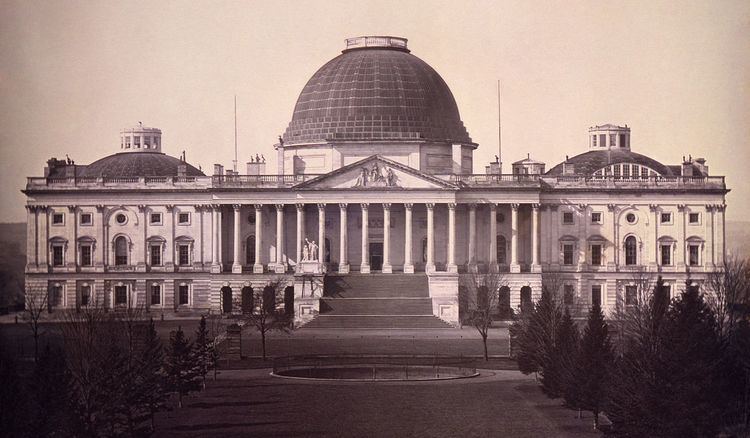The Thirty-first United States Congress was a meeting of the legislative branch of the United States federal government, consisting of the United States Senate and the United States House of Representatives. It met in Washington, D.C. from March 4, 1849 to March 4, 1851, during the 16 months of the Zachary Taylor presidency and the first eight months of Millard Fillmore's. The apportionment of seats in this House of Representatives was based on the Sixth Census of the United States in 1840. The Senate had a Democratic majority, while there was a Democratic plurality in the House.
March 4, 1849: Zachary Taylor became President of the United StatesDecember 22, 1849: Howell Cobb is elected Speaker after sixty-three ballots, the longest election for the position ever held.March 7, 1850: Senator Daniel Webster gave his "Seventh of March" speech in which he endorsed the Compromise of 1850 to prevent a possible civil warJuly 9, 1850: Taylor died and Millard Fillmore became President.September 9, 1850: Compromise of 1850, sess. 1, chs. 48-51, 9 Stat. 446 - 9 Stat. 458September 18, 1850: Fugitive Slave Act, sess. 1, ch. 60, 9 Stat. 462September 20, 1850: "An Act to suppress the Slave Trade in the District of Columbia," sess. 1, ch. 63, 9 Stat. 467September 29, 1850: Donation Land Claim Act, sess. 1, ch. 76, 9 Stat. 496States admitted and territories organized
September 9, 1850 — As part of the Compromise of 1850:Texas's borders were changed, ch. 49, 9 Stat. 446New Mexico Territory was organized, ch. 49, 9 Stat. 448California was admitted as a state into the Union, ch. 50, 9 Stat. 452Utah Territory was organized, ch. 51, 9 Stat. 453During this Congress, two Senate seats were added for the new state of California.
During this Congress, two House seats were added for the new state of California.
President: Millard Fillmore (W), until July 9, 1850; vacant thereafter.President pro tempore: David Atchison (D), until May 5, 1850William R. King (D), from May 6, 1850Speaker: Howell Cobb (D)Democratic Caucus Chairman: James ThompsonThis list is arranged by chamber, then by state. Senators are listed in order of seniority, and Representatives are listed by district.
Senators were elected by the state legislatures every two years, with one-third beginning new six-year terms with each Congress. Preceding the names in the list below are Senate class numbers, which indicate the cycle of their election. In this Congress, Class 1 meant their term ended with this Congress, facing re-election in 1850; Class 2 meant their term began in the last Congress, facing re-election in 1852; and Class 3 meant their term began in this Congress, facing re-election in 1854.
Skip to House of Representatives, belowThe names of members of the House of Representatives are preceded by their district numbers.
The count below reflects changes from the beginning of the first session of this Congress.
replacements: 5Democrats (D): no net changeWhigs (W): no net changedeaths: 1resignations: 3seats from newly admitted states: 2interim appointments: 4Total seats with changes: 8replacements: 11Democrats (D): 2 seat net gainWhigs (W): 2 seat net lossdeaths: 8resignations: 5contested election:1seats from newly admitted states: 2Total seats with changes: 16Lists of committees and their party leaders.
AgricultureAudit and Control the Contingent Expenses of the SenateCalifornia's Admission to the Union (Select)ClaimsCommerceDisorder in the Senate of April 17, 1850 (Select)Distributing Public Revenue Among the States (Select)District of ColumbiaEligibility of James Shields (Special)FinanceForeign RelationsFrench Spoilations (Select)Indian AffairsJudiciaryManufacturesMexican Boundary Commission (Select)Military AffairsMilitiaNaval AffairsOrdnance and War Ships (Select)Patents and the Patent OfficePensionsPost Office and Post RoadsPrintingPrivate Land ClaimsPublic Buildings and GroundsPublic LandsRetrenchmentRevolutionary ClaimsRoads and CanalsSeventh Census (Select)Settlement of the Slavery Question (Select)Tariff Regulation (Select)TerritoriesWholeAccountsAgricultureBounty Land Act of 1850 (Select)ClaimsCommerceDistrict of ColumbiaElectionsEngravingExpenditures in the Navy DepartmentExpenditures in the Post Office DepartmentExpenditures in the State DepartmentExpenditures in the Treasury DepartmentExpenditures in the War DepartmentExpenditures on Public BuildingsForeign AffairsIndian AffairsInvalid PensionsManufacturesMileageMilitary AffairsMilitiaNaval AffairsPatentsPost Office and Post RoadsPublic Buildings and GroundsPublic ExpendituresPublic LandsRevisal and Unfinished BusinessRevolutionary ClaimsRoads and CanalsRulesStandards of Official ConductTerritoriesWays and MeansWholeEnrolled BillsLibrarian of Congress: John Silva MeehanChaplain: Henry Slicer (Methodist)Clement M. Butler (Episcopalian), elected January 9, 1850Secretary: Asbury DickensSergeant at Arms: Robert BealeChaplain: Ralph Gurley (Presbyterian)Clerk: Thomas J. Campbell, died April 13, 1850Richard M. Young, elected April 17, 1850Doorkeeper: Robert E. HornerPostmaster: John M. JohnsonSergeant at Arms: Adam J. Glossbrenner 
